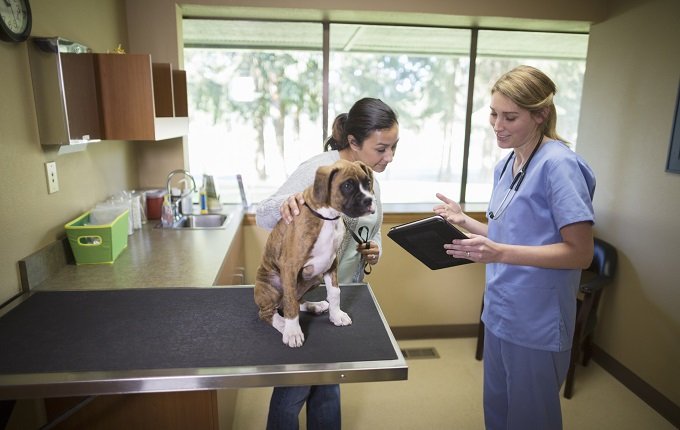Cephalexin is an antibiotic that can be given to dogs to kill a range of bacteria and fight off infection. People and other animals can use it, too.
Veterinarians usually prescribe cephalexin to dogs as an oral medication that can come in liquid, tablet, or capsule forms. It’s sometimes spelled “cefalexin,” or it can be referred to by its brand names, which include Keflex, Rilexine, Sporidex, Biocef, and Keftab.
If your vet has prescribed cephalexin for your dog, then you should ask them about proper dosage and possible side effects. You must consult your vet before giving your dog any medication.
With your vet’s prescription, you can easily get your dog’s medication online through Chewy’s Pharmacy. Your pet prescriptions will be delivered right to your doorstep in less than a week. You can even add your pet prescriptions to Autoship, so you never have to remember to order refills.
Click here to browse Chewy’s Pharmacy for your pets’ health needs, and click here to buy cephalexin with your vet’s prescription!
Here’s what you should know about cephalexin for dogs.
Uses Of Cephalexin For Dogs

Cephalexin is one of the most useful antibiotics for vets, and it’s effective in fighting a broad spectrum of gram-positive and gram-negative bacteria in dogs. It causes the cell walls of bacteria to rupture, and vets mostly prescribe it for uncomplicated infections.
Here are a few of the conditions vets may treat with cephalexin:
- Staphylococcal infections, commonly called staph infections
- Urinary tract infections
- Hot spots on the skin
- Bone infections
- Respiratory tract infections
- Ear infections
- Infections cause by Streptococcus pneumonia or Streptococcus pyogenes
- E. coli infections
- Haemophilus influenza
- Klebsiella pneumonia
- Proteus mirabilis
Vets may also prescribe cephalexin as a preventative measure to protect against heart valve infection.
In cases of certain wounds or abscesses, including injuries received during a fight with another dog or animal, cephalexin may be administered to prevent infection.
Dosage Of Cephalexin For Dogs

You must rely on your vet’s dosage instructions. The following is meant to describe the typical dosage for this medication, but your vet may adjust it for your individual dog.
The usual dosage of cephalexin in dogs is 10 to 15 mg for each pound of body weight. However, concentration of the drug can vary, and you should read the instructions and follow your vet’s advice thoroughly.
Typically vets recommend pet parents give their dogs the drug every eight to twelve hours, so two to three times per day. Owners can provide it to their dogs with or without food, though giving the medication to dogs with food can reduce the potential side effects.
It’s important that you keep up the regimen your vet has prescribed. Treatment with cephalexin generally lasts for seven to ten days.
Overdose is typically not a problem, but it can cause gastrointestinal issues like diarrhea or vomiting. If your dog is sensitive to the drug, then it could make these problems worse and cause a dangerous reaction. In the case of an overdose, seek veterinary attention.
Side Effects Of Cephalexin For Dogs

Before giving cephalexin to your dog, you must make your veterinarian aware of any other medication your dog is taking, any history of medical conditions, especially kidney disease, and any bad reactions your dog has had to medications in the past, particularly penicillin or cephalosporins.
Any of these can lead to complications when administering cephalexin.
Common side effects of cephalexin in dogs include vomiting, diarrhea, and weight loss. However, giving a dog food with the medication will often reduce these side effects. Further side effects include panting and drooling, skin rashes, hyperexcitability, and rapid breathing.
In rare cases, a dog may experience kidney damage or decreased motor control. If symptoms become severe, then you should contact your veterinarian.
Dogs who are allergic to the drug may experience rashes, fever, or anaphylaxis, which can be a deadly reaction. Long-term use can also cause decreased platelet count, granulopenia, hepatitis, kidney issues, and neutropenia.
Click here to buy cephalexin for your dog with your vet’s prescription!
Pet Parents can also leverage Chewy’s telehealth service, Connect with a Vet to connect online with licensed veterinarians to answers all pet-related questions and concerns! Free to Autoship customers, Connect with a Vet lets you chat directly with a licensed vet between 8am and 11pm ET to answer questions, receive advice, discuss concerns you might have regarding the health and wellness of your pet, and even get referrals to your local vets or emergency clinics.
Check out Chewy’s Online Pharmacy and Connect with a Vet service!
Have you used cephalexin for your dog? Did it improve your dog’s condition? Then let us know in the comments below!






